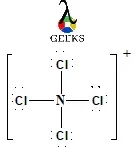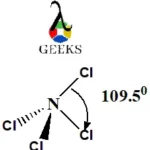Ncl4+ is an inorganic moiety with a molecular mass of 155.8g/mol. Let us see how nitrogen is bonded to chlorine atoms as given below.
Nitrogen is connected to each chlorine via a single bond and also involved its lone pairs in the bonding. The positive sign on the structure indicated that there is no lone pair left with nitrogen itself.
The other important aspects of the ncl4+, like the rule regarding its lewis structure, shape and hybridization are explained in the given below sections of the article.
How to draw ncl4+ lewis structure
Ncl4 is an inorganic molecule which comprises four chlorine atoms. The following given rules can be used to draw the lewis structure for ncl4+.
1. Total count of valence electrons
The ncl4 involves a total of 33 valence electrons. Nitrogen contributes 5 electrons and each chlorine atom donates 7 electrons. Hence, 5 + 7*4 -1 = 32 electrons. The 1 is subtracted from the total to represent the + sign on the central atom.
2. Placement of the central atom
In the ncl4+ lewis structure, nitrogen occupies the central position and the rest of the atoms will place around the nitrogen. This is because according to the rule, the atom with less electronegative character will place at the centre.
3. Arrangement of the bond pairs
In this step, all the valence electrons pairs in the form of a single bond will place between the nitrogen and chlorine atoms. This is because every atom is a sigma donor. Therefore, firstly only a sigma bond will place and then opt for a double bond.

Ncl4+ lewis structure resonance
The phenomenon of resonance involves the movement of electrons within the molecule. This way resonance adds flexibility to the system. Let us look for ncl4+.
The resonance can not be possible for ncl4+. This is due to the reason that there are no vacant orbitals available for the electrons to move. Hence, no delocalization.
Ncl4+ lewis structure shape
The shape of any molecule is usually decided by the location of its valence electrons. The shape for the ncl4+ lewis structure is given below.
The structural shape for ncl4+ is tetrahedral. This is because the formation of ncl4 involves 1 s and 3p orbitals. Therefore, the perfect shape for such an orbital arrangement is tetrahedral.
Ncl4+ lewis structure formal charge
The total charge associated with an ion or molecule after its bonding is called a formal charge. The calculation for the formal charge for ncl4 is described below.
The formal charge for ncl4+ is +1. The formula used for the calculation of the formal is formal charge = valence electrons – unbonded electrons -1/2 bonded electrons.
Calculation of formal charge for the nitrogen and chlorine atoms are given below.
| Atoms involved | Valence electrons | Unbonded electron count | Bonded electrons | Formal charge |
| 1. Nitrogen atom | 5 | 0 | 8 | 5-0+8/2 = 1 |
| 2. Chlorine atom | 7 | 6 | 2 | 7-6-2/2 =0 |
Ncl4+ lewis structure angle
The magnitude of the angle for any molecule depends upon the type of shape attained by that particular molecule. Let us look angle for ncl4+.
The structural angle for ncl4+ is 109.50.This value is attained because ncl4 has adopted a tetrahedral shape. In the structure, two atoms occupied the planar positions and the rest two at wedge and dash respectively together giving a perfect appearance of tetrahedral angle.

Ncl4+ lewis structure octet rule
According to the octet rule, every atom must have 8 electrons or a stable electronic configuration after the formation of the molecule. Let us find out for ncl4+.
Ncl4+ obeys the octet rule. This is because nitrogen contains 8 electrons in its outermost core and each chlorine atoms also get full-filled after the bonding. Hence this way, both the atoms got 8 electrons in their sub-shell.
Ncl4+ lewis structure lone pairs
Lone pairs or spectator pairs are those who do not participate directly in bonding. Now, let us count the lone pairs for ncl4+.
Ncl4+ has a total of 18 lone pairs. The total lone pairs present on nitrogen is zero. However, each chlorine atom is associated with 6 lone pairs with them. In ncl4+, the lone pair of nitrogen is involved in the bonding and therefore it carries a positive sign with it.
Ncl4+ valence electrons
Valence electrons are those which are capable of participating in bond formation. Let us count the valence electron count for ncl4+.
- Total valence electrons associated with ncl4+ are 32.
- Nitrogen belongs to group 15th of the periodic group and hence has electronic configuration = [He] 2s22p3 ie. 5 electrons in the subshell.
- Chlorine belongs to the halogen family and has electronic configuration = [Ne] 3s²3p⁵ ie. 7 valence electrons.
- Total valence count calculation = 5 + 7*4 = 33-1 =32.
Ncl4+ hybridization
The intermixing of the chlorine and nitrogen orbitals to form ncl4+ is called hybridization. Further details about the ncl4+ hybridization are given below.
The hybridization for ncl4+ is sp3. Since nitrogen forms four bond bonds. This indicates that nitrogen needs 4 hybrid orbitals. For the formation of ncl4+, all the four orbitals were involved indicated the 25% of s character and rest 75% attributed to p character in the molecule.
Is ncl4+ a solid?
Solid refers to the state of a substance only when the intended substance has a definite shape, volume and weight. Let us look for ncl4+.
Ncl4+ is solid. This is due to the larger size of the chlorine atoms. Due to the size, the intermolecular forces are favourable for the solid state.
Is ncl4+ soluble in water?
The solubility factor of any molecule indicates what kind of solvent is suitable for the given compound. Let us check if ncl4+ is soluble in water or not.
The ncl4+ is not soluble in water. This is because there are no unpaired electrons that are available in the molecule to interact with the water molecule.
Why and how ncl4+ is not soluble in water?
The ncl4+ does not dissolve in water. This happened because there is a need for the formation of a hydrogen bond with ncl4+. However, the filled p orbital of nitrogen does not leave any place to accept any electrons coming from the water molecule.
Is ncl4+ polar or nonpolar?
Polar and non-polar nature is decided by its molecular structure. The details about the polarity attributes of ncl4+ are given below.
The ncl4+ is non-polar. This is because ncl4 has opted for a tetrahedral geometry and hence net magnetic moment comes out to zero.
Why and how ncl4+ is non-polar?
Ncl4+ is non-polar because, in the tetrahedral arrangement of the ncl4+, each atom is placed in such a way that cancels out the magnetic moment of each other.
Is ncl4+ a molecular compound?
A molecular compound contains more than one type of different atoms within the molecule. Let us go through the molecular composition of ncl4+.
Ncl4+ is a molecular compound because it full-filled the definition of both molecules as well as compounds. In this way, it comprises of total 5 atoms of two different types.
Is ncl4+ an acid or base?
Acid is any substance which either accepts or gives away its proton while the base donates the electron pair. Let us look for ncl4+.
Ncl4+ is an acid. This is because nitrogen gives away its cationic part when dissolve in the given solution. In this way, it satisfied the condition of the acid.
Is ncl4+ an electrolyte?
If the given substance generates ions in the aqueous solution which is further responsible for providing current is called an electrolyte. Let us observe for ncl4+.
Ncl4+ on its own can not be considered an electrolyte. However, when it is bonded with a counter ion of opposite ion like No3– then it becomes an ionic entity and can easily dissociate to give ions.
Is ncl4+ a salt?
Salt is a substance which comprises anionic and cationic parts. Let us discuss if ncl4 fulfilled the definition of salt or not.
Ncl4+ is consider a salt only when it comes along with counter ion. As ncl4+ is a cationic ion a sit carries a positive sign and can not be stayed independently and always present with a counter ion of opposite sign. In this way, it completes the requirement of being a salt entity.
Is ncl4+ ionic or covalent?
Covalent bonds are formed by the mutual sharing of electrons whereas ionic bonds are formed either by giving electrons or donating. Let us observe for ncl4+.
Ncl4+ consists of both ionic as well as a covalent bonds. In the ncl4+ structure, nitrogen is attached to the three chlorine atoms via covalent bonding and one ionic bond is established with the remaining chlorine.
What is the oxidation state of nitrogen in ncl4+?
The oxidation state refers to the valency of the atom. Let us find out the oxidation state of the nitrogen atom in ncl4+.
The oxidation state of nitrogen is +5. The oxidation state of nitrogen is calculated by the below-given method.
- The total charge on the molecule = +1
- The total charge on the chlorine = -1
- Oxidation state of ncl4+ = +1 = 1+4 = +5
Conclusion
Ncl4+ has an oxidation state of +5 and covalent in nature with sp3 hybridization along with a perfect tetrahedral angle of 109.50
Read more about Helium Structure and Characteristics
XeO2 Lewis structure & characteristics
NCl2+ Lewis Structure& Characteristics
Also Read:
- Xef2o lewis structure
- Cl2o2 lewis structure
- Lih lewis structure
- Sco lewis structure
- Secl4 lewis structure
- Hydrochloric acid lewis structure
- Clo2 lewis structure
- H2so4 lewis structure
- Bf3 lewis structure
- Xecl4 lewis structure

Hello…Myself is Pomila Sharma. I have done my master’s in Chemistry with a specialization in synthetic organic chemistry. I have published 4 research articles. I am very passionate about the chemistry world. I believe it’s all about chemistry so let’s explore it together.